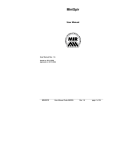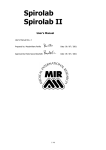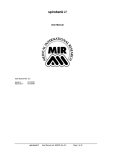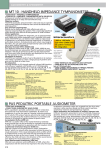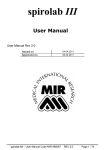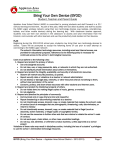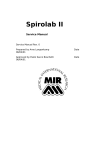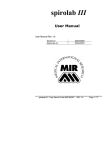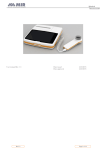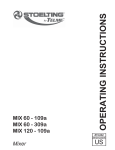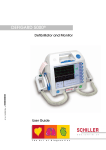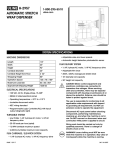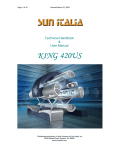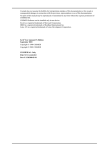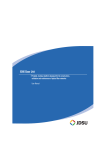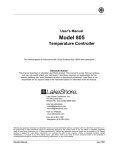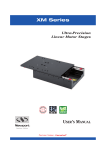Download Minispir 2 User Manual
Transcript
ENGLISH MiniSpir User Manual User Manual Rev. 1.1 Issued on: Approved on: 09/03/2012 09/03/2012 MINISPIR User manual Rev 1.1 pagina 1 di 22 WARNING The paper mouthpiece, the nose clip and the disposable turbine with mouthpiece in the equipment should be considered disposable products. Before using your MiniSpir … Read this manual carefully, plus all labels and other product information supplied. Set the device configuration (date, time, predicted values, language etc.) as described in the Software WinspiroPro Manual. Check PC system requirements for compatibility with the device (RAM: 512 Mb minimum, 1024 Mb preferred; Operating system: Windows 2000 – XP Windows Vista (32bit/64bit)- Windows 7 (32bit/64bit); Minimum disk space: 500 Mb; CPU Pentium IV-class PC 1 GHz; display resolution 1024x768 or higher. MiniSpir should only be connected to a computer manufactured in compliance with EN 60950/1992. WARNING The winspiroPRO PC software supplied with the device MUST be installed correctly to the PC before connecting MiniSpir to the PC. At the end of the installation, connect the device to the PC and the hardware will be "recognised" by the PC. The device can then be used with the winspiroPRO software. Keep the original packaging! In the event that your device requires attention then always use the original packaging to return it to the distributor or the manufacturer. In such an event then please follow these guidelines: Return the complete device in the original packaging, and The transport (plus any customs or taxes) costs must be prepaid. Manufacturer’s address MIR SRL: VIA DEL MAGGIOLINO, 125 00155 ROME (ITALY) Tel ++ 39 0622754777 Fax ++ 39 0622754785 Web site: www.spirometry.com Email: [email protected] MIR has a policy of continuous product development and improvement, and the manufacturer therefore reserves the right to modify and to update the information contained in this User’s Manual as required Any suggestions and or comments regarding this product should be sent via email to: [email protected]. Thank you. MIR accepts no responsibility for any loss or damage caused by the User of the device due to the use of this Manual and/or due to an incorrect use of the product. Copying this manual in whole or in part is strictly forbidden. FEDERAL LAW RESTRICTS THIS DEVICE TO SALE BY OR ON THE ORDER OF A PHYSICIAN MINISPIR User manual Rev 1.1 pagina 2 di 22 ENGLISH Thank you for choosing a product from MIR MEDICAL INTERNATIONAL RESEARCH 1. INTRODUCTION.................................................................................................................................................................. 4 1.1 Intended Use ................................................................................................................................................................. 4 1.1.1 User Category ........................................................................................................................................................... 4 1.1.2 Ability and experience required ................................................................................................................................. 4 1.1.3 Operating environment ............................................................................................................................................. 4 1.1.4 Who can or must make the installation ..................................................................................................................... 4 1.1.5 Subject effect on the use of the device ..................................................................................................................... 4 1.1.6 Limitations of use - Contraindications ....................................................................................................................... 4 1.2 Important safety warnings ............................................................................................................................................. 5 1.2.1 Danger of cross-contamination ................................................................................................................................. 5 1.2.2 Turbine ...................................................................................................................................................................... 5 1.2.3 Mouthpiece ............................................................................................................................................................... 6 1.2.4 Oximetry sensor ........................................................................................................................................................ 6 1.2.5 USB Connection Cable ............................................................................................................................................. 7 1.2.6 Device ....................................................................................................................................................................... 7 1.3 Unforeseen errors ......................................................................................................................................................... 7 1.4 Labels and symbols....................................................................................................................................................... 7 1.4.1 Identification label ..................................................................................................................................................... 8 1.4.2 Electrical safety symbol ............................................................................................................................................ 8 1.4.3 Warning symbol for the WEEE Directive ................................................................................................................... 8 1.4.4 Mark of conformity with the Medical Device Directive ............................................................................................... 8 1.4.5 Warning symbol for the USB serial port .................................................................................................................... 8 1.4.6 Warning symbol for the SpO2 port for oximetry ........................................................................................................ 8 1.4.7 (ESD) Electrostatic discharge sensitivity symbol ...................................................................................................... 8 1.5 Product description........................................................................................................................................................ 8 1.6 Technical features ....................................................................................................................................................... 10 1.6.1 Features of the spirometer ...................................................................................................................................... 10 1.6.2 Features of the oximeter ......................................................................................................................................... 10 1.6.3 Other features ......................................................................................................................................................... 11 2. FUNCTIONING OF THE MiniSpir ...................................................................................................................................... 11 2.1 Connection to PC ........................................................................................................................................................ 11 2.2 Using the MiniSpir ....................................................................................................................................................... 12 2.3 ......................................................................................................................................Errore. Il segnalibro non è definito. 2.4 Spirometry Testing ...................................................................................................................................................... 12 2.5 Spirometry test interpretation ...................................................................................................................................... 12 2.6 Oximetry testing .......................................................................................................................................................... 13 3. DATA TRANSMISSION ..................................................................................................................................................... 15 3.1 Transmission with USB cable ...................................................................................................................................... 15 3.2 Upgrade Internal software ........................................................................................................................................... 15 4. MAINTENANCE ................................................................................................................................................................. 16 4.1 Cleaning and controlling the reusable turbine ............................................................................................................. 16 4.2 Cleaning the oximetry sensor ...................................................................................................................................... 16 4.3 Changing the adhesive tape of the wrap sensor ......................................................................................................... 16 5. PROBLEM SOLVING......................................................................................................................................................... 17 5.1 Causes and Solutions ................................................................................................................................................. 17 ANNEX 1 INFORMATION FOR CORRECT USE IN ELECTROMAGNETIC ENVIRONMENTS ............................................ 20 MINISPIR User manual Rev 1.1 pagina 3 di 22 ENGLISH INDEX ENGLISH 1. INTRODUCTION 1.1 Intended Use MiniSpir spirometer and pulse oximeter is intended to be used either by a physician, respiratory therapist or technician. The device is intended to test lung function and can make: spirometry testing in people of all ages, excluding infants and neonates oximetry testing in people of all ages. It can be used in any setting. 1.1.1 User Category MiniSpir calculates a series of parameters relating to human respiratory function. The product is therefore intended for use by a doctor or by a trained paramedic or technician under the supervision of a doctor. 1.1.2 Ability and experience required The correct use of the device, the interpretation of the results and the maintenance of the device, with particular attention to disinfection (cross-contamination risk), all require qualified personnel. WARNING The manufacturer cannot be held responsible for any damage caused by the user of the device failing to follow the instructions and warnings contained in this manual. The MiniSpir when used as a pulse oximeter is intended for spot-checking oximetry. 1.1.3 Operating environment MiniSpir has been designed for use in a doctor’s office or in a hospital setting. All information necessary for the proper use of the device in surrounding electromagnetic environments (as required by the EN 60601-1-2) is specified in Annex I. The instrument is not intended for use in an operating theatre nor in the presence of inflammable liquids or detergents, nor in the presence of inflammable anaesthetic gases, oxygen or nitrogen. The instrument is not designed to be used in direct air currents (e.g. wind), sources of heat or cold, direct sun rays or other sources of light or energy, dust, sand or any other chemical substances. The user is responsible for ensuring that the device is stored and used in appropriate environmental conditions as specified in paragraph 1.7.3. WARNING If the device is exposed to unsuitable environmental conditions, this could cause the device to malfunction and to give incorrect results. 1.1.4 Who can or must make the installation The device requires installation by qualified personnel. 1.1.5 Subject effect on the use of the device A spirometry test should only be carried out when the subject is at rest and in good health, and thus in a suitable condition for the test. A spirometry test requires the collaboration of the subject since the subject must make a complete forced expiration, in order to have a meaningful test result. 1.1.6 Limitations of use - Contraindications An analysis of the results of a spirometry test is not by itself sufficient to make a correct diagnosis of the subject’s clinical condition. A detailed clinical history of the subject is also required together with the results of any other test(s) suggested by a doctor. Test comments, a test interpretation and suggested courses of treatment must be given by a doctor. A spirometry test requires the collaboration of the subject. The results depend on the person’s capability to inspire and to expire all air completely and as fast as possible. If these fundamental conditions are not respected then the results obtained during spirometry testing will not be considered accurate, and therefore the test results are “not acceptable”. The acceptability of a test is the responsibility of the user. Special attention should be given to testing elderly subjects, children and handicapped people. The device should never be used when it is possible or probable that the validity of the results may be compromised due to an y such external factors. WARNING MiniSpir when used as a pulse oximeter has limited alarms, therefore the device requires frequent PC display observation of SpO2 and pulse rate. MINISPIR User manual Rev 1.1 pagina 4 di 22 ENGLISH 1.2 Important safety warnings MiniSpir has been examined by an independent laboratory which has certified the conformity of the device to the Safety Standards IEC 60601-1 and guarantees the EMC Requirements within the limits laid down in the Standard IEC 60601-1-2. MiniSpir is throughly tested during its production and therefore the product complies with the safety requirements and quality standards laid down by the Council Directive 93/42/EEC for MEDICAL DEVICES. After removing the device from its packaging, check that there is no visible damage. In case of damage do not use the device and return it to the manufacturer for replacement. WARNING The safety and the correct performance of the device can only be assured if the user of the device respects all of the relevant safety rules and regulations. The manufacturer cannot be held responsible for damage caused by the failure of the user to follow these instructions correctly. The device must be used according with the indications given by the manufacturer in the User Manual with particular attention to § Intended Use utilizing only original spare parts and accessories. Use of non original parts such as the turbine flow sensor and oximetry sensor or other accessories may cause errors in measurement and/or compromise the correct functioning of the device, and is therefore not permitted. In the event of any incident or accident of any kind resulting from the use of the device, the user is required to inform the manufacturer without delay, according with Directive 93/42/EEC on Medical Devices. 1.2.1 Danger of cross-contamination Two different types of turbine sensors can be used with the device: one is single-patient disposable and one is reusable. A mouthpiece is required in order to connect a subject to the spirometer. In order to avoid exposing the subject to the hazard of cross-contamination, the reusable flow sensor must always be cleaned before each spirometry test, and a new disposable mouthpiece must always be used for each subject. The use of an anti bacterial filter is at the discretion of the doctor. If a disposable turbine is used, then a new one must be used for each patient. 1.2.2 Turbine Disposable turbine If you are going to perform the spirometry test with a disposable turbine, it is important to use a new turbine for every new patient. The characteristics, accuracy and the hygiene of the disposable turbine can only be guaranteed if it has been stored beforehand in its original sealed packaging. The disposable turbine is made of plastic and its disposal after use should adhere to the local authority guidelines / norms. Reusable turbine The correct funtioning of the re-usable turbine can only be guaranteed if it has been cleaned in the correct manner and is free from foreign bodies which could alter its movement. If the turbine has not been cleaned sufficiently this could cause cross contamination from one patient to another. The cleaning of the turbine should be done following the guidelines in the user manual. The following informations are valid for both models of turbine. Do not expose the turbine to a direct jet of water or air, and avoid contact with high temperature liquids. Do not allow dust or foreign bodies to enter the turbine sensor, in order to avoid incorrect functioning and possible damage. The presence of any impurities (such as hair, sputum, threads etc.) within the body of the turbine sensor may seriously compromise the accuracy of the measurements. Notes about calibration of reusable turbine WARNING The turbine flow sensor does not require calibration but needs only a regular cleaning. If a calibration must be made then the following guidelines should be carefully noted. Calibration can be made using a siring a calibration syringe ad making a FVC test. In line with the publication "Standardised Lung Function Testing" of the European Respiratory Society (Vol 6, Supplement 16, March 1993), the air expired from the mouth is at a temperature of circa 33/34 °C. The expired flow and volume, to be converted to BTPS conditions (37 °C) must be increased by 2.6% - this is derived from the BTPS factor of 1.026 at a temperature of 33°C, which represents a correction of 2.6%. In practice the BTPS factor for the expired flow and volumes is therefore constant and equal to 1.026. For the inspired volumes and flows, the BTPS factor depends upon the ambient temperature as the air inspired is at ambient temperature. For instance at an ambient temperature of 20°C with relative humidity at 50%, the BTPS factor is 1.102, a correction of +10.2%. MINISPIR User manual Rev 1.1 pagina 5 di 22 1.2.3 Mouthpiece Any disposable mouthpieces included with the device are supplied only as a guide to the correct type and dimensions of the mouthpiece required for this device, they are clean but not sterile. To purchase appropriate mouthpieces, generally either paper or plastic but in any case mono-use/disposable, we suggest that you contact your local distributor who supplied the spirometer. WARNING The use of a mouthpiece made from an inappropriate material could modify the bio-compatibility and could be the cause of an incorrect functioning of the device and thus of incorrect test results, and create inconvenience to the patient. The user is responsible for obtaining the correct type of mouthpieces for the device. Those required are a standard type with an outside diameter of 30 mm, they are commonly used and in general easily procured. To avoid contamination of the environment, caused by the disposal of used mouthpieces, the user must follow all of the relevant local regulations in force. 1.2.4 Oximetry sensor The oximetry sensors which can be used with MiniSpir are the following: BCI 1300 adult sensor (disposable) BCI 3026 wrap-around sensor for infants BCI 3043 universal Y sensor BCI 3078 ear sensor BCI 3178 pediatric finger sensor, reusable BCI 3444 adult sensor reusable (Comfort Clip) BCI 3044 adult sensor, reusable, for finger. These sensors require the use of an extension cable to be correctly connected to the device: the extension cables available are: code 919200 lenght 1,5 m code 919210_INV lenght 0,5 m Prolonged use and/or the patient’s condition may require changing the sensor site periodically. Change sensor site and check skin integrity, circulatory status, and correct alignment at least every 4 hours. WARNING Incorrectly applied sensors or damaged cables may cause inaccurate readings. Using a damaged sensor may cause inaccurate readings, possibly resulting in patient injury or death. Inspect each sensor before use. If a sensor appears damaged, do not use it. Use another sensor or contact your authorized repair centre for assistance. Use only MIR sensors supplied with, or specifically intended for use with the MiniSpir. Use of sensors not intended for use with the MiniSpir may cause inaccurate readings. Oximetry measurements may be inaccurate in the presence of high ambient light. Shield the sensor area (with a surgical towel, for example) if necessary. WARNING Dyes introduced into the bloodstream, such as methylene blue, indocyanine green, indigo carmine, patent blue V (PBV), and fluorescein may adversely affect the accuracy of the oximetry reading. MINISPIR User manual Rev 1.1 pagina 6 di 22 ENGLISH The correction of the inspired volumes and flows is made automatically as the machine has an internal temperature sensor; the BTPS values are thus calculated. If a 3L syringe is used to make the calibration and if the MiniSpir is calibrated correctly then the FVC (syringe) value will be: 3.00 (FVC) x 1.026 (BTPS) = 3.08 L (FVC at BTPS). If the ambient temperature is 20°C, the FIVC (syringe) value will be: 3.00 (FIVC) x 1.102 (BTPS) = 3.31 L (FIVC at BTPS). The user must be aware that the volume of the syringe shown by the machine is converted to BTPS conditions, so that the "increase" of the results with respect to the expected values does not constitute an error. For instance, if the calibration procedure is carried out with measured data: FVC = 3.08 L and FIVC = 3.31 L at an ambient temperature of 20°C the resulting correction factor becomes: EXPIRATION .00% INSPIRATION .00% This does not represent an error, but is a logical consequence of the explanation detailed above. Significant levels of dysfunctional hemoglobins, such as carboxyhemoglobin or methemoglobin, may adversely affect the accuracy of the oximetry measurement. Optical cross-talk can occur when two or more sensors are placed in close proximity. Optical cross-talk may adversely affect the accuracy of the oximetry readings. The danger can be eliminated by covering each site with opaque material. Obstructions or dirt on the sensor’s emitter and/or detector may cause a sensor failure or inaccurate readings. Make sure there are no obstructions and the sensor is clean. Autoclaving, ethylene oxide sterilizing, may cause sensor damage. Do not attempt to sterilize the sensor. Unplug the sensor from MiniSpir before cleaning or disinfecting to prevent damaging sensor or device, and to prevent safety hazards for the user. 1.2.5 USB Connection Cable Incorrect use or application of the USB cable may produce inaccurate measurements, which will show very inaccurate values of the patient’s condition. Carefully inspect each cable before use. Do not use cables that appear to be or are damaged. If a new cable is required, contact your local distributor. Use only cables supplied by MIR, specifically designed to be used with MiniSpir. The use of other types of cables can lead to inaccurate measurements. 1.2.6 Device WARNING The maintenance operations detailed in this manual must be carried out to the letter. If these instructions are not followed this can cause measurement errors and/or an incorrect test interpretation. Any modifications, adjustments, repairs or reconfiguration must be made by the manufacturer or by personnel authorised by the manufacturer. In case of problems, never attempt to make a repair oneself. The set-up of configurable parameters should only be made by qualified personnel. However, an incorrect set up of the parameters does not put the patient at risk. High-frequency emissions from “electronic” devices may interfere with the correct operation of the instrument. For this reason, certain minimum clearances (a few metres) should be observed when high-frequency appliances such as a TV, radio, portable phone, etc. and other electronic units are operated at the same time in the same room. The instrument may give inaccurate readings if operated in the presence of strong electromagnetic sources or in the presence of other medical devices such as echographies. If the PC connected to MiniSpir is used in the area containing the patient, it is necessary that the PC complies with the EN 60601-1 Standard (ref. EN 60601-1-1 Standard). For the disposal of the MiniSpir, the accessories, plastic consumable materials (mouthpieces) plus the battery, use only the appropriate containers or return all such parts to the seller of the instrument or to a recycling centre. All applicable local regulations must be followed. If any of these rules are not followed then MIR will decline all responsibility for any direct or indirect damages, however caused. 1.3 Unforeseen errors If any problems should arise with the device, a message indicating the nature of the problem will appear on the screen of the PC, together with a warning “beep”. Errors in measurement or in interpretation can also be caused by: use by non-qualified or non-trained personnel, lacking ability or experience user error use of the instrument outside the guidelines described in this User's Manual use of the instrument even when some operational anomalies are encountered non-authorised servicing of the instrument. 1.4 Labels and symbols MINISPIR User manual Rev 1.1 pagina 7 di 22 ENGLISH Any condition that restricts blood flow, such as the use of a blood pressure cuff or a device for systemic vascular resistance, may cause an inability to determine accurate pulse rate and SpO2 readings. Remove fingernail polish and/or false fingernails before applying SpO2 sensors. Both may cause inaccurate oximetry measurement. ENGLISH 1.4.1 Identification label The label shows: Serial number of the device Product name Name and address of the manufacturer Electrical safety symbol Warning symbol for the WEEE Directive Mark of conformity with the Medical Device Directive 1.4.2 Electrical safety symbol In accordance with IEC 60601-1 this product and its component parts are of type BF and therefore protected against the hazards of direct and indirect contact with electricity. 1.4.3 Warning symbol for the WEEE Directive This symbol is laid down in the 2002/96/EEC regarding the waste of electrical and electronic equipment (WEEE). At the end of its useful life this device must not be disposed of as normal domestic waste. Instead it must be delivered to a WEEE authorised collection centre. As an alternative, the device may be returned without charge to the dealer or distributor, when it is replaced by another equivalent device. Due to the construction materials used for the device, disposing it as a normal waste product could cause harm to the environment and/or health. Failure to observe these regulations can lead to prosecution. 1.4.4 Mark of conformity with the Medical Device Directive 0476 This product is certified to conform to the Class IIa requirements of the 93/42/EEC Medical Devices Directive. 1.4.5 Warning symbol for the USB serial port 1.4.6 Warning symbol for the SpO2 port for oximetry SpO2 1.4.7 (ESD) Electrostatic discharge sensitivity symbol The (ESD) symbol required by the international standard EN 60601-1-2 is used in the vicinity of any connector which has not undergone electrostatic discharge testing. 1.5 Product description MiniSpir is a spirometer and pulse oximeter, and is connected to a Personal Computer using a USB cable. MINISPIR User manual Rev 1.1 pagina 8 di 22 ENGLISH The device measures a range of respiratory parameters, and the saturation of oxygen in the blood and the heart beat. The main features of this multipurpose MiniSpir make it is easy to use and versatile. Spirometry function MiniSpir calculates up to 30 functional respiratory parameters, as well as the parameter comparison after the administration of a drug (PRE/POST) for a bronchodilator test or for a bronchial challenge test. A comparison of data is made between POST (after-drug) and PRE (before drug administration). The Pre test data relates to percentage variations between the measured results and the predicted values based on the anthropometric data inserted. The flow and volume measurement sensor is a digital turbine, based on the infrared interruption principal, which ensures accuracy in time as required from a professional device. The special features of this kind of sensor are listed below: Accurate measurement even at very low flow rates (end of expiration) Not affected by gas humidity nor density Shockproof and unbreakable Inexpensive to replace. The two versions of the turbine flow measurement sensors, used on MiniSpir (single-patient disposable or reusable), ensure high precision in measurements and have the great advantage of requiring no periodic calibration (however, the turbines can be calibrated if required by the doctor). REUSEABLE TURBINE DISPOSABLE TURBINE In order to maintain the characteristics of the turbines the following precautions must be closely observed: for the single-patient disposable turbine: they must always be substituted between patients. for the reusable turbine: always clean the turbine between patients, to ensure the maximum level of hygiene and safety for the patient. For a correct interpretation of a spirometry test, the measured values must be compared either to the so-called normal or predicted values which are calculated from the anthropometric details of the patient or, alternatively, to the personal best values from the clinical history of the subject. The personal best values can vary considerably from the predicted values, which are taken from “healthy” subjects. MiniSpir is connected to a PC trough a USB port. Data measured by MiniSpir are transferred to the PC in real-time. The Windows “winspiroPro” software allows to view the spirometric test results (flow/volume curves, spirometry parameters) plus the related subject detail. The data measured by MiniSpir and arranged by the software are available for interpretation by specialised personnel. The software gives an interpretation of each spirometry test by assigning a “traffic light” code and by comparing the previous values of the same subject or the reference values of the subject’s group. For further details see the online manual of the WinSpiroPro Software. MiniSpir is able to make FVC, VC & IVC, MVV and breathing profile tests, calculates an index of test acceptability (quality control) plus reproducibility of the spirometry tests carried out. The automatic test interpretation follows the latest 11 level ATS (American Thoracic Society) classification. Each test can be repeated as required. The best parameters are always available for review. The normal (predicted) values can be selected from several normal “sets”. For example, within the European Union the majority of doctors use the ERS (European Respiratory Society) predicted values. For the configuration of parameters and storing tests, see the online manual of the WinSpiroPro Software. Oximetry function (optional) The oximetry sensor has two light emitting diodes (LEDs), one emits in the visible spectre and one infrared. Both lights then pass through the finger and are “read” by the receiver. As these lights pass through the finger, a proportion of the light is MINISPIR User manual Rev 1.1 pagina 9 di 22 1.6 Technical features There follows a comprehensive description of the main features of the device. 1.6.1 Features of the spirometer Measured parameters: SYMBOL FVC FEV1 FEV1% FEV3 FEV3/FVC FEV6 FEV6% PEF FEF25 FEF50 FEF75 FEF2575 FET Vext FIVC FIV1 FIV1/FIVC PIF ELA *FVC *FEV1 *PEF VC IVC IC ERV FEV1/VC VT VE Rf ti te ti/t-tot VT/ti MVV(cal) DESCRIPTION Forced Vital Capacity st Volume expired in the 1 second of the test FEV1/FVC x100 Volume expired in the initial 3 seconds of the test FEV3/FVC x 100 Volume expired in the initial 6 seconds of the test FEV1/FEV6 x 100 Peak Expiratory Flow Forced Expiratory Flow at 25% of FVC Forced Expiratory Flow at 50% of FVC Forced Expiratory Flow at 75% of FVC Flow ratio at 25% and at 75% Forced expiratory time Extrapolated volume Forced inspiratory volume st Volume inspired in the 1 second of the test FIV1/FIVC x 100 Peak inspiratory flow Estimated lung age Best FVC Best FEV1 Best PEF Slow vital capacity (expiratory) Slow inspiratory vital capacity Inspiratory capacity (max between EVC and IVC) - ERV Expiratory reserve volume FEV1/VC x 100 Tidal volume Ventilation per minute, at rest Respiratory frequency Average time of inspiration, at rest Average time of expiration, at rest Average time of inspiration / total time Average inspiratory flow, at rest Maximum voluntary ventilation calculated on FEV1 m.u. L L % L % L % L/min L/s L/s L/s % S mL L L % L/s years L L L/s L L L L % L L/min S S min L/s L/min *= best values Flow/volume measurement system Temperature sensor Measurement principle Volume range Flow range Volume accuracy Flow accuracy Dynamic resistance at 12 L/s 1.6.2 Bi-directional digital turbine semiconductor (0-45°C) Infrared interruption 10 L 16 L/s 3% or 50 mL 5% or 200 mL/s <0.5 cmH2O Features of the oximeter Measured parameters: SYMBOL SpO2 Baseline SpO2 Min SpO2 Max SpO2 Mean DESCRIPTION SpO2 Average in first three minutes SpO2 Minimum during analysis period SpO2 Maximum during analysis period SpO2 Average during analysis period MINISPIR User manual Rev 1.1 Units % % % % pagina 10 di 22 ENGLISH absorbed by the blood and by the soft tissue, in function of the concentration of heamoglobin. The quantity of light absorbed, at each frequency, depends on the degree of oxygenation of the haemoglobin inside the soft tissue. This measurement principal ensures accuracy and reproducibility, without requiring regular calibration. DESCRIPTION Average pulse frequency in the first 3 minutes Minimum pulse frequency during the analysis period Maximum pulse frequency during the analysis period Average pulse frequency during the analysis period Total time measure of SpO2 Total time of analysis Time passed with SpO2 < 90 % Time passed with SpO2 < 89 % Time passed with SpO2 < 88 % Time passed with SpO2 < 87 % Fall of SpO2 below 89 % for at least 20 seconds Index of SpO2 fluctuation calculated in intervals of 12 seconds Time passed with pulse frequency < 40 BPM Time passed with pulse frequency > 120 BPM Bradycardia events during the entire analysis period Tachycardia events during the entire analysis period Units BPM BPM BPM BPM hh:mm:ss hh:mm:ss % hh:mm:ss % hh:mm:ss % hh:mm:ss % hh:mm:ss \ \ % hh:mm:ss % hh:mm:ss \ \ =DELTA Red and infrared absorption 0 – 99% (with 1% increments) 2% between 70-99% SpO2 Measurement method %SpO2 range %SpO2 accuracy Average number of heart beats for %SpO2 calculation cardiac pulse range 8 beats cardiac pulse accuracy Average interval for the calculation of cardiac pulse Signal quality indication 30 – 300 BPM (with 1 BPM increments) 2 BPM or 2% 8 seconds 0 - 8 segments on display The specifications for both the oximetry and for the cardiac pulse are the same, regardless of which of the above mentioned oximetry sensors is used. 1.6.3 Other features Interface Power supply Dimensions Weight Storage conditions Operating conditions Compliance with standards Type of electrical protection Grade of electrical protection Grade of protection against water ingress Level of safety in the presence of inflammable anaesthetic gas, oxygen or nitrogen Conditions of use 2. 2.1 USB USB connection 127x52x15 142x49.7x26mm 65 grams Temperature: MIN -20 °C, MAX + 60 °C Humidity: MIN 10% RH; MAX 95%RH Temperature: MIN + 10 °C, MAX + 40 °C; Humidity: MIN 10% RH; MAX 95%RH Electrical Safety Standard IEC 60601-1 EMC Standard IEC 60601-1-2 Class II BF IPX0 Not suitable Device for continuous use FUNCTIONING OF THE MiniSpir Connection to PC WARNING Before connecting MiniSpir to a PC, the winspiroPro software must be installed on the PC in order to interface it with the device. MINISPIR User manual Rev 1.1 pagina 11 di 22 ENGLISH SYMBOL BPM Baseline BPM Min BPM Max BPM Mean Recording time Analysis Time T90 T89 T88 T87 N. SpO2 Events < 89% Index (12sec) T< 40 BPM T> 120 BPM Bradycar. Events < 40 BPM Tachycar. Events>120 BPM 2.2 Using the MiniSpir For correct use of the device and for setup of data required for the interpretation of the results (initial setup, turbine calibration, patient data management, viewing previous data and interpretation of results) see the winspiroPro software manual. 2.3 Spirometry Testing WARNING The device must only be used by qualified personnel with complete knowledge of spirometry; this is important for the correct execution of the tests, for the acceptability of measured parameters as well as for the correct interpretation of results. For correctly carrying out a spirometry test, it is strongly recommended to carefully follow the instructions as described below. Insert the mouthpiece supplied into the hollow part of the turbine by at least 0.5 cm. Fit the nose clip onto the nose of the subject to ensure that air cannot escape through the nostrils. Hold MiniSpir in one hand as you would a cell phone. The side with the ID label should be in the hand of the user. Insert the mouthpiece well into the mouth beyond the teeth, being carefully to ensure that air cannot escape from the sides of the mouth. It is suggested to make testing in a standing position and during an expiration lean forward, in order to help the expiratory action with a compression of the abdomen. WARNING Do not touch the USB cable during a test to avoid interfering with the transfer of data to the PC or stopping a test too soon. Please note it is indispensable for an accurate spirometry that all air must be expired from lungs. It is important to stress that the disposable mouthpiece and turbine must be changed at the end of each test. After 6 seconds from the initial forced expiratory MiniSpir emits a continuous beep,. This is useful to the doctor to understand if the patient has reached the minimum expiry time pursuant to the requirements as set forth by the major international associations of pneumology. 2.4 Spirometry test interpretation The interpretation of these indices %, according to the ATS standards, generates a series of messages which correspond to possible levels of obstruction or restriction plus one level of normal spirometry, as shown in the following table: normal mild moderate moderately severe severe very severe Through an analysis applied to some of the indices and parameters calculated in the FVC test, MiniSpir produces a variety of quality control comments useful to understand the reliability of the test made. This control quality check assigns a letter for the current session as described below: MINISPIR User manual Rev 1.1 pagina 12 di 22 ENGLISH To make the connection, insert the micro USB connector of the USB connection cable already included in the packaging, into MiniSpir, as shown in the picture. Next, attach the other connector to the USB port of the PC. When initially making a connection, the PC will, , either make an automatic driver installation or request some information. To avoid errors in this phase please read the winspiroPRO User Manual very carefully. To control the proper connection between the device and the PC check that the led on the device is lit. POST Test A = two acceptable (1) FEV1 values matching within 100 mL B= two acceptable (1) FEV1 values matching within 200 mL C= two acceptable (1) FEV1 values that do not match within 200 mL D= only one acceptable (1) FEV1 manoeuvre F= No acceptable (1) FEV1 manoeuvres Acceptable manoeuvre means: good start and satisfactory exhalation (duration and flow) Where several comments related to the single test are calculated, MiniSpir will only show the most important to facilitate the test interpretation. ERROR IN Vext and PEF If the extrapolated volume Vext is greater than 500 mL or greater than 5% of the FVC, or if the PEFT (time to peak flow) is greater than 300 ms, then the following comment is shown: INITIAL EXPIRATION TOO SLOW FET error If FET is under the predicted threshold the following message appears: EXPIRY TIME INSUFFICENT <6s FLOW ERROR If the last flow point of the F/V curve is greater than 200 mL/s, this indicates that the expiration was not complete and thus the following comment is shown: BLOW OUT ALL AIR IN LUNGS Between two tests, MiniSpir evaluates the repeatability of the following parameters: PEF VC repeatable when the difference between the two largest PEF is ≤ 0.67 L/s; repeatable when the difference between the two largest VC is ≤ 150 mL; If FVC is > 1.0 L then: FEV1 repeatable when the difference between the two largest FEV1 is ≤ 150 mL; FVC repeatable when the difference between the two largest FVC is ≤ 150 mL; if FVC is ≤ 1.0 L then: FEV1 repeatable when the difference between the two largest FEV1 is ≤ 100 mL; FVC repeatable when the difference between the two largest FVC is ≤ 100 mL; 2.5 Oximetry testing WARNING If MiniSpir as been purchased without the oximetry option, then only spirometry tests can be made WARNING The sensors described below are for illustration purposes only. MiniSpir is enabled for the use of any of the sensors described in the Paragraph 1.2.4. MIR does not recommend the use of a specific type of sensor; any decision in regard is made by the individual doctor. Re-usable finger sensor This sensor is recommended for patients weighing > 20 Kg with limited activity. MINISPIR User manual Rev 1.1 pagina 13 di 22 ENGLISH PRE Test A = At least two acceptable manoeuvres, with the highest two FEV1 values matching to within 100 mL and the largest two FEV6 values within 100 mL. B= At least two acceptable manoeuvres, with the FEV1 values matching to within 101 to 150 mL C= At least two acceptable manoeuvres, with FEV1 values matching to within 151 to 200 mL D= only one acceptable manoeuvres, or more than one, but the FEV1 values not matching to within 200 mL (with no interpretation). F= No acceptable manoeuvres (with no interpretation). ENGLISH Carry out an oximetry test as follows: Connect the sensor to the instrument: insert the connector with the arrow (printed on the connector) face-up, as shown: Choose a high perfusion site, easily adaptable to the sensor Insert finger into the sensor until the finger touches the end of the probeEnsure that the bottom part of the finger completely covers the detector. If the finger is not able to be correctly positioned, use another finger. Position the sensor so that the cable is underneath the top of the hand. This enables the light source to remain on the fingernail and the detector on the bottom part of the finger. WARNING In order not to compromise the reproducibility of the measurements and the integrity of the sensor, avoid twisting the sensor cable and handle it with care when using, connecting, disconnecting and when placing the finger into it. During the first few seconds of the test the device searches for the best signal, after which the timer re-sets to zero and MiniSpir starts to memorise the data. If the sensor has not been correctly inserted, the message “Sensor unplugged” will appear on the PC screen. If the sensor has been inserted but the finger is not inserted correctly, the message “Finger not detected correctly” will appear on the PC screen. If the sensor correctly receives the signal, after a few seconds the device starts to ‘beep’ and the values will be displayed on the PC screen. WARNING A test is archived using the name of last patient visualised. If this refers to a patient whose data has already been inserted in the past, call up a previous test carried out on the patient in question and proceed as described in the final part of paragraph 2.6. WARNING For archiviations method of the tests please see on line manual of winspiroPRO software Reusable "wrap" sensor The use of this sensor is indicated for patients weighing more than 30 Kg and contraindicated for patients with allergy to adhesive tape. WARNING The materials used for manufacturing the sensor are NATURAL LATEX PROTEIN free. The materials used for the sensor are subject to biocompatibility tests. Adult Single Patient Sensor – Instructions for Use MINISPIR User manual Rev 1.1 pagina 14 di 22 This sensor is indicated for patients weighing over 30 kg and is contraindicated for use on patients who exhibit allergic reactions to the adhesive tape. Do not reuse. One use on one patient. Choose an application site on the patient’s finger or toe where the light source will be directly over and in-line with the detector. The preferred sites are the forefinger or smaller thumb. Remove nail polish or artificial fingernails Place the patient’s digit in the sensor nail-side up, lining up the digit’s pad over the detector. The sensor’s positioning line runs across the mid axis of the fingertip Wrap the bottom adhesive around the digit, being careful not to cover the nail. Fold the sensor’s top over the digit, making sure the light source is directly over and in-line with the detector. Wrap the adhesive around the finger or toe to secure the sensor. Route the cable along the palm or the bottom of the foot, and secure with adhesive tape if necessary. Connect the sensor to the instrument: insert the connector with the arrow on the connector face-up and control the correct functioning according to the previous instructions. WARNING Do not twist unnecessarily or use excessive force when using, connecting, disconnecting, or storing the sensor. An over-tight sensor can produce inaccurate saturation measurements. Therefore avoid over tightening the adhesive tape. It is recommended to fasten the cable to the wrist with a bandage. 3. DATA TRANSMISSION WARNING Read the instructions carefully before starting the transmission of data taking due care in ensuring that all the information has been properly understood. 3.1 Transmission with USB cable All data in the MiniSpir is transferred through a USB cable connection. Refer to Paragraph 2.1 of this Manual to connect the device to a PC. The data measured by MiniSpir during a spirometry test are sent to the PC in digital form and managed by the winspiroPro software. WARNING Do not disconnect MiniSpir from the PC during a test. Before to disconnect MiniSpir from the PC close winspiroPRO software. To disconnect MiniSpir remove the USB cable from the PC connector. For more details read the winspiroPRO user manual. 3.2 Upgrade Internal software MiniSpir software can be upgraded when connected to a PC via USB. Upgrades can be downloaded by registering on www.spirometry.com. For further information on upgrading software see the winspiroPro software manual. MINISPIR User manual Rev 1.1 pagina 15 di 22 ENGLISH WARNING ENGLISH 4. MAINTENANCE MiniSpir is an instrument that requires very limited maintenance. The operations to perform periodically are: Cleaning and controlling of the reusable turbine Changing the single-patient disposable turbine at each test Cleaning of the oximetry sensor (for reusable sensors) Changing the adhesive tape of the oximetry wrap sensor The maintenance operations set forth in the User’s Manual must be carried out carefully. Failing to observe the instructions contained in the manual may cause errors in measurement or in the interpretation of measured values. Modifications, adjustments, repairs, and reconfiguration must be carried out by the manufacturer or authorised persons. In case problems arise do not attempt to personally repair the unit. The setting of configuration parameters must be carried out by qualified personnel. In any case the risks pertaining to incorrect settings do not constitute a hazard for the patient. 4.1 Cleaning and controlling the reusable turbine The turbine utilized on MiniSpir belongs to one of two categories: disposable and reusable. Both guarantee precise measurements and have the great advantage of requiring no periodic calibration. In order to maintain the characteristics of the turbine a simple cleaning is required prior to each use (only for the reusable turbine). Cleaning of the disposable turbine is not required, as it is supplied clean in a sealed plastic bag. It must be disposed of after use. It is a good practice to control from time to time that dirt or foreign bodies are not deposited inside the turbine such as threads or hair. Any such deposit could brake or block the rotation of the turbine blade and thus compromise the measurement accuracy. To clean the reusable turbine, remove it from its compartment on the MiniSpir by turning it anti-clockwise and pressing lightly. It can be helpful to push it gently from underneath with one finger. Immerse the turbine in the recommended cold detergent solution, and move it within the liquid to remove any impurities which may be deposited inside. Leave the turbine immersed for the time specified in the instruction of the solution. To avoid any kind of damage to the reusable turbine please do not use any alcoholic or oily substances, do not immerge the turbine in hot water or hot solution. Do not put the turbine under a direct jet of water or other liquid. If no detergent solution is available, clean the turbine in clean water. MIR suggest the use of Perasafe, manufactured by Dupont, which has been tested with positive results on all MIR sensors. Rinse the turbine by immerging it in clean water (not hot). Shake off the excess water from the turbine and leave it to dry, standing it vertically on a dry surface. Once the turbine has been cleaned insert the turbine tube in its place according to the direction as indicated by the closed lock symbol printed on the plastic casing of the MiniSpir. To correctly insert the turbine push it to the end and turn it clockwise until reaching the wedge which ensures that the tube has been blocked inside the plastic casing. When using the disposable turbine, do not clean it, but change it after each test. 4.2 Cleaning the oximetry sensor Clean the sensor with a soft cloth moistened with water or a mild soap solution. To disinfect the sensor, rub with isopropylic alcohol. Allow the sensor to dry completely after cleaning. WARNING Do not sterilize by irradiation, steam, or, ethylene oxide. Do not immerse in liquids. Before cleaning or disinfecting the sensor, unplug it from the device. 4.3 Changing the adhesive tape of the wrap sensor The adhesive tape is made with latex-free material. Gently remove the used adhesive tape from the sensor and dispose of it. The back of the sensor has alignment pins. Place the sensor with the alignment pins facing the adhesive part of the tape and align the pins to the holes on the tape. MINISPIR User manual Rev 1.1 pagina 16 di 22 Push the sensor so as to insert the pins into the holes of the tape. Lift both the sensor and the tape and check that the pins of the sensor are correctly aligned. It is suggested to use a new piece of adhesive tape for each sensor for each patient, or as required. 5. PROBLEM SOLVING PROBLEM MESSAGE \ MiniSpir does not connect with the PC Spirometry data at the end of the test are not acceptable \ \ \ \ During an oximetry test the values are wrong, irregular \ 5.1 POSSIBLE CAUSES The USB cable is not correctly connected REMEDY Check the correct connection of the USB cable side Pc and side device. The driver doesn’t work Check the presence of the correctly device in the list of USB devices connected. Try to remove and connect the device. The turbine don’t rotate Clean the turbine and correctly check another time; use a new turbine The test is performed in Repeat the test following a wrong way the indications on the screen The sensor is positioned Put the sensor in another in a wrong way or the position. perfusion index of the patient is low The patient is moving To obtain an accurate measurement the patient should not make sudden movements. Causes and Solutions Check that the two connectors of the USB cable and the PC are correctly inserted. If the position is correct the USB connection icon will appear in the tool bar; otherwise re-install the driver of the device. At end of spirometry testing the test data is not correct Clean the turbine and then control it; use a new turbine. MINISPIR User manual Rev 1.1 pagina 17 di 22 ENGLISH ENGLISH MEDICAL INTERNATIONAL RESEARCH Via del Maggiolino, 125 00155 - Roma - ITALY DECLARATION OF CONFORMITY CE (annex II excluding par.4) We hereby declare that the following device: Type Brandname Device name Class Spirometer/Oximeter MIR Medical International Research MiniSpir IIa Complies with the Essential Requirements of directive 93/42/EC concerning Medical Devices, and its amendments, and its transposition in the Member States. This statement is made on the basis of the CE Certificate n. MED 9826 issued by Cermet, Notified Body n. 0476. Rome ………………………. Paolo Sacco Boschetti The Chairman MINISPIR User manual Rev 1.1 pagina 18 di 22 ENGLISH LIMITED WARRANTY CONDITIONS MiniSpir, together with its standard accessories is guaranteed for a period of 12 months if intended for professional use (doctors, hospitals, etc.). The warranty is effective from the date of purchase contained in the relevant sales invoice or proof of purchase. The instrument must be checked at the time of purchase, or upon delivery, and any claims must be made immediately in writing to the manufacturer. This warranty covers the repair or the replacement (at the discretion of the manufacturer) of the product or of the defective parts without charge for the parts or for the labour. All batteries and other consumable parts are specifically excluded from the terms of this guarantee. This warranty is not valid, at the discretion of the manufacturer, in the following cases: If the fault is due to an improper installation or operation of the machine, or if the installation does not conform to the current safety norms in the country of installation. If the product is utilised differently from the use described in the Users Manual. If any alteration, adjustment, modification or repair has been carried out by personnel not authorised by MIR. If the fault is caused by lack of or incorrect routine maintenance of the machine. If the machine has been dropped, damaged or subjected to physical or electrical stress. If the fault is caused by the mains or by another product to which the instrument has been connected. If the serial number of the instrument is missing, tampered with and/or not clearly legible. The repair or replacement described in this warranty is supplied for goods returned at the customers’ expense to our certified service centres. For details of these centres please contact your local supplier of the spirometer or contact the manufacturer directly. The customer is responsible for the transportation and for all transport and customs charges as well as for delivery charges of the goods both to and from the service centre. Any instrument or accessory returned must be accompanied by a clear and detailed explanation of the defect or problem found. If units are to be returned to the manufacturer then written or verbal permission must be received before any instruments are returned to MIR. MIR Medical International Research, reserves the right to modify the instrument if required, and a description of any modification made will be sent along with the returned goods. MINISPIR User manual Rev 1.1 pagina 19 di 22 INFORMATION FOR CORRECT USE IN ELECTROMAGNETIC ENVIRONMENTS Guidance and manufacturer’s declaration – electromagnetic emissions The MiniSpir is intended for use in the electromagnetic environment specified below. The customer or the user of the MiniSpir should assure that it is used in such an environment. Emissions test Compliance Electromagnetic environment – guidance RF emissions Group 1 The MiniSpir uses RF energy only for its CISPR 11 internal function. Therefore, its RF emissions are very low and are not likely to cause any interference in nearby electronic equipment. RF emissions Class B CISPR 11 Harmonic emissions Not applicable IEC 61000-3-2 Voltage fluctuations/ Not applicable flicker emissions IEC 61000-3-3 Guidance and manufacturer’s declaration – electromagnetic immunity The MiniSpir is intended for use in the electromagnetic environment specified below. The customer or the user of the MiniSpir should assure that it is used in such an environment. Immunity test IEC 60601 Compliance level Electromagnetic environment test level –guidance Electrostatic discharge (ESD) IEC 61000-4-2 Electrical fast transient/burst ±6 kV contact ±4 kV contact ±8 kV air ±8 kV air ±1 kV input/output lines IEC 61000-4-4 Surge for ±1 kV differential mode Not Applicable IEC 61000-4-5 Voltage dips, short interruptions and voltage variations on power supply input lines IEC 61000-4-11 ±2 kV common mode <5 % UT (>95 % dip in UT) for 0,5 cycle Floors should be wood, concrete or ceramic tile. If floors are covered with synthetic material, the relative humidity should be at least 30 %. Mains power quality should be that of a typical commercial or hospital environment. Mains power quality should be that of a typical commercial or hospital environment. Not Applicable 40 % UT (60 % dip in UT) for 5 cycles 70 % UT (30 % dip in UT) for 25 cycles Power frequency (50/60 Hz) magnetic field <5 % UT (>95 % dip in UT) for 5 sec 3 A/m 3 A/m Power frequency magnetic fields should be at levels characteristic of a typical location in a typical commercial or hospital environment. IEC 61000-4-8 Portable and mobile RF communications equipment should be used no closer to any part of the MiniSpir, including cables, than the recommended separation distance calculated from the equation applicable to the frequency of the transmitter. Recommended separation distance d=[ 3.5 ] √P 3 Conducted RF 3 Vrms [3 ] V IEC 61000-4-6 150 kHz to 80 MHz d=[ 3.5 ] √P 80 MHz to 800 GHz 3 d=[ 7 3 Radiated RF 3 V/m IEC 61000-4-3 80 MHz to 2,5 GHz ] √P 800 MHz to 2,5 GHz [3 ] V/m where P is the maximum output power rating of the transmitter in watts (W) according to the transmitter manufacturer and d is the recommended separation distance in metres (m). Field strengths from fixed RF transmitters, MINISPIR User manual Rev 1.1 pagina 20 di 22 ENGLISH ANNEX 1 Interference may occur in the vicinity of equipment marked with the following symbol: NOTE UT is the a.c. mains voltage prior to application of the test level. NOTE 1 At 80 MHz and 800 MHz, the higher frequency range applies. NOTE 2 These guidelines may not apply in all situations. Electromagnetic propagation is affected by absorption and reflection from structures, objects and people. a Field strengths from fixed transmitters, such as base stations for radio (cellular/cordless) telephones and land mobile radios, amateur radio, AM and FM radio broadcast and TV broadcast cannot be predicted theoretically with accuracy. To assess the electromagnetic environment due to fixed RF transmitters, an electromagnetic site survey should be considered. If the measured field strength in the location in which the MiniSpir is used exceeds the applicable RF compliance level above, the MiniSpir should be observed to verify normal operation. If abnormal performance is observed, additional measures may be necessary, such as reorienting or relocating the MiniSpir. b Over the frequency range 150 kHz to 80 MHz, field strengths should be less than [3] V/m. MINISPIR User manual Rev 1.1 pagina 21 di 22 ENGLISH as determined by an electromagnetic site survey, should be less than the compliance level in each frequency range.b ENGLISH Recommended separation distances between portable and mobile RF communications equipment and the MiniSpir The MiniSpir is intended for use in an electromagnetic environment in which radiated RF disturbances are controlled. The customer or the user of the MiniSpir can help prevent electromagnetic interference by maintaining a minimum distance between portable and mobile RF communications equipment (transmitters) and the MiniSpir as recommended below, according to the maximum output power of the communications equipment. Rated maximum output power of transmitter W 0.01 0.1 1 10 100 Separation distance according to frequency of transmitter m 150 kHz to 80 MHz 80 MHz to 800 MHz 800 MHz to 2,5 GHz d=[ 3.5 ] √P V1 0.12 0.37 1.17 5.28 11.66 d=[ 3.5 ] √P E1 d=[ 7 ] √P E1 0.24 0.74 2.34 1.056 23.32 0.24 0.37 1.17 5.28 11.66 For transmitters rated at a maximum output power not listed above, the recommended separation distance d inmetres (m) can be estimated using the equation applicable to the frequency of the transmitter, where P is themaximum output power rating of the transmitter in watts (W) according to the transmitter manufacturer. NOTE 1 At 80 MHz and 800 MHz, the separation distance for the higher frequency range applies. NOTE 2 These guidelines may not apply in all situations. Electromagnetic propagation is affected by absorption and reflection from structures, objects and people. MINISPIR User manual Rev 1.1 pagina 22 di 22






















